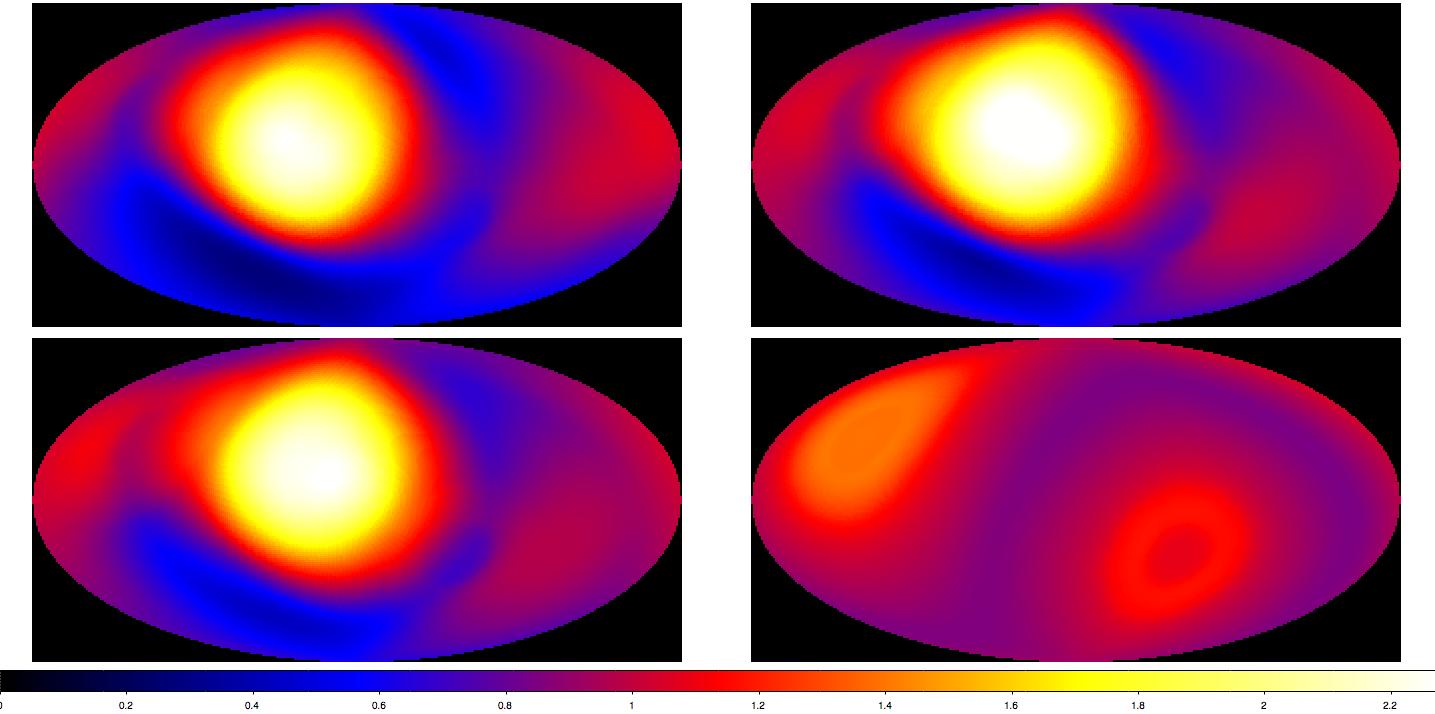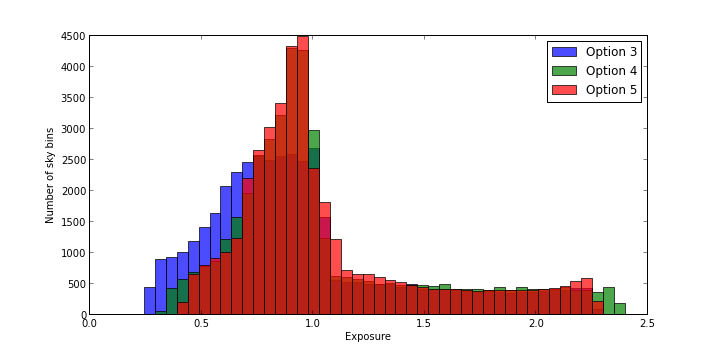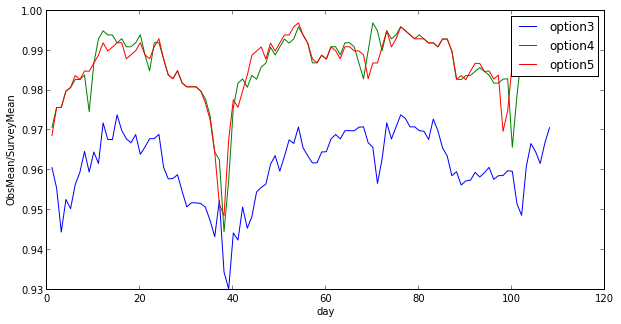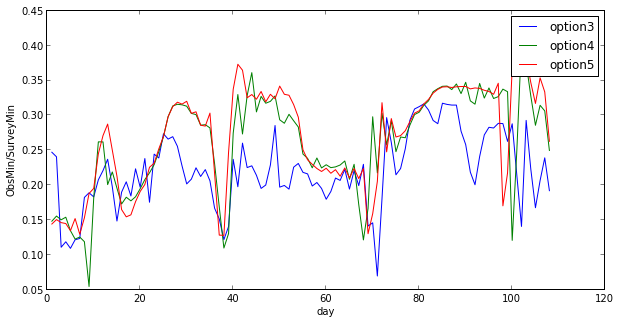Alternative Observing Strategies Carried Out During Fermi Mission Cycle 6
Alternative Observation Strategies
This page is retained for historical reference only. During mission Cycle 6 alternative sky-survey strategies, driven by scientifically motivated community input, were developed to enhance coverage of the central regions of the galaxy. Cost-benefit analysis guiding the implementation details are presented below.
Following the solar-array drive anomaly in in 2018 there is less planning and scheduling flexibility and exercises such as this are highly unlikely to be accommodated in the future.
Background
Since the start of science operations of the Fermi mission in August 2008, the default observation mode has been an all-sky survey, optimized to provide relatively uniform coverage of the entire sky every three hours. However, Fermi is capable of flexible survey mode patterns, and inertially pointed observations both of which allow increased coverage of selected parts of the sky. The survey and observation modes can be combined or modified to execute alternate observing strategies that more effectively accommodate specific science drivers, such as a desire for increased sensitivity to flaring sources in the northern hemisphere, or monitoring sources near the galactic center. As we approach the 5-year anniversary of the Fermi launch, it is time to consider new approaches that will continue Fermi's success for many more years.
On March 27, 2013, the Fermi Project solicited "white papers" from the scientific community and received five which detailed specific alternative observing strategies and quantitatively discussed the scientific benefits of each. In August, a panel was convened to review the proposals and recommended a transition to the option 4 modified survey observation strategy, or similar, no later than December 2013.
The Recommended Alternative ("Option 4")
- Implementation should occur by December 2013. The time between now and then is needed to solicit community comment on the recommendation and to run some observatory thermal models to better understand the impact of this new observing strategy.
- The modified observing strategy should run for one year.
- After one year is up, the Fermi Project Scientist will organize a review to decide whether to maintain the modified observing strategy or return to survey mode.
More details on the committee's process, motivation and the impact on science and operations can be found in the full report.
Option 4

Option 4 is a modified survey mode which biases the exposure toward the galactic center. It is a combination of inertial pointings of a target with RA = 261.4 (5 degree offset from the Galactic center RA) and a declination chosen to be on the Fermi orbit equator. This provides relatively uniform all-sky coverage while simultaneously providing a boost in exposure at the Galactic center.
An 108 day orbit/attitude simulation was made for each strategy (Options 1 - 4 are listed at the bottom of this page), along with a 50 degree rocking survey profile for comparison. For more details, scroll to the Proposed Alternative Observing Strategies section.
Option 4 spacecraft (ft2) file | Comparison survey spacecraft (ft2) file | Evaluation
Exposure Maps

Exposure Distribution

Mean Exposure

Minimum Exposure

Exposure at the Galactic Center

History
August 7, 2013
The panel report on observation strategies is now available. The recommendation is to transition to the option 4 observation strategy, or similar, no later than December 2013. The full text of the report can be found here.
July 25, 2013
On July 25, a meeting was held to discuss and evaluate the white papers. The agenda for this meeting can be found here.
July, 2013
The Fermi project received five alternative observing strategy papers in response to the solicitation below. In each case, the submitting groups have consented to their public dissemination. The papers are now posted for download.
March 27, 2013:
Since the start of science operations of the Fermi mission in August 2008, the default observation mode has been an all-sky survey, optimized to provide relatively uniform coverage of the entire sky every three hours. However, Fermi is capable of flexible survey mode patterns, and inertially pointed observations both of which allow increased coverage of selected parts of the sky. The survey and observation modes can be combined or modified to execute alternate observing strategies that more effectively accommodate specific science drivers, such as a desire for increased sensitivity to flaring sources in the northern hemisphere, or monitoring sources near the galactic center. As we approach the 5-year anniversary of the Fermi launch, it is time to consider new approaches that will continue Fermi's success for many more years.
To help guide future observation plans, the Fermi Project is soliciting "white papers" from the scientific community. These should detail specific alternative observing strategies and discuss, in a quantitative way, the scientific benefits. We emphasize that this solicitation differs from a call for proposals, in that it is not a competitive peer review. Multiple ideas, or combinations thereof may ultimately be implemented. Continuing dialogs between any groups involved and the Fermi Project are also encouraged.
The Fermi Science Support Center can assist proposers with technical aspects of their plans. Questions can be sent by email to the Fermi Help desk or directly to the project scientist, Julie McEnery.
Proposed Alternative Observing Strategies
Examples of potential observing strategies are given below. They include the spacecraft (FT2) files used to generate the all sky exposure maps and a quantitative evaluation of the results. When appropriate, observing strategies can be evaluated according to the following considerations.
Evaluation
- Exposure integrated over a precession period. Compare the maximum and minimum exposure as a fraction of some constant reference value OR fraction of what would have been achieved in survey mode.
It's also helpful to make a histogram of exposure in equal area bins to get a sense of what fraction of the sky wins and what fraction looses (and by how much). Integrating the exposure on the sky (with suitable zenith cut) and comparing with standard survey mode provides a measure of the efficiency of the observation (i.e. how much exposure is lost due to zenith cuts).
- Exposure as a function of time to evaluate monitoring capabilities. This can be a metric for source monitoring. For example, consider how often the LAT would miss a flare of 1e-6 photons cm-2 s-1 integrated over one day, relative to sky survey mode. This would need to be evaluated for each day of a precession period using the exposure maps.
- Time spent in FoV, or within 45 degrees of LAT boresight. by the location of the source of interest. For the LAT, sensitivity to sources is good within 45 degrees of the LAT boresight. Additionally, such as when looking at bright solar flares, line sensitivity is approximately uniform out to 45 degrees.
- Exposure relative to Sun position. This may not be relevant for all strategies. An observation strategy that always looks away from the Sun will obviously have a severe impact on solar science. Conversely, an observation strategy that always looks towards the Sun will have a severe impact on other science because we will always be looking at the part of the sky that TeV, X-ray and optical telescopes cannot observe.
- Maximizing average all-sky exposure. Observations that bring the LAT FoV across the Earth lose some exposure due to Earth blockage. Thus changing the observation strategy doesn't just redistribute exposure, it can also result in loss of exposure due to zenith cuts applied to data selection.
Example Strategies
- Option 1: Point at RA, Dec 261.4, -28.9 corresponding to a 5 degree offset in RA from the Galactic Center. Make the transition into a 50 degree rocking survey when the target is 10 degrees from Earth occultation. Commence slew back to the target when target is exiting 10 deg from earth occultation. EAA is set to 30 degrees, so the LAT boresight will track to within 30 deg of Earth limb and then hold steady until target reaches 10 degrees from the Earth limb.
Option 1 spacecraft (ft2) file | Comparison survey spacecraft (ft2) file | Evaluation
- Option 2: Similar to option 1, but point toward the celestial equator, offset from Galactic Center by 28.9 deg, to get better sky uniformity on short timescales.
Option 2 spacecraft (ft2) file | Comparison survey spacecraft (ft2) file | Evaluation
- Option 3: Similar to option 2, but shifts the Declination of the pointed target toward the orbit equator once per week. The shift results in a varying offset from the Galactic Center, but keeps the Galactic Center within the field of view. The sky uniformity on short timescales is significantly improved with respect to options 1 and 2.
Option 3 spacecraft (ft2) file | Comparison survey spacecraft (ft2) file | Evaluation
- Option 4: Similar to option 3, but transition to 50 deg rocking profile sky survey when target is 30 deg from occultation. This has the advantage that the EAA can now be set to 5 deg and ARR performance is preserved.
Option 4 spacecraft (ft2) file | Comparison survey spacecraft (ft2) file | Evaluation
Standard Fermi Observing Modes
Current Fermi observing modes, including the predominant rocking survey mode, are describe below.
Autonomous Repoint:
After exceeding a pre-determined threshold for a bright GBM-detected GRB a 2.5 hour pointed Autonomous repoint observation (ARR) at location the GRB is initiated onboard the spacecraft as an inertial pointing. A limb following mode is used while the target location is occulted by the Earth.
Target of Opportunity
A Target of Opportunity (TOO) observation is an unplanned pointed observation deemed immediately significant for Fermi. Typically the TOO interrupts the scheduled observing mode as less than a 1 week long observation. The TOO transitions to a planned pointed observation if the duration is more than a few days. A limb following mode is used while target location is occulted.
Pointed mode observation
This mode is simply a planned inertial pointing for a specific target. Survey mode or a secondary target pointing is employed when the primary target location is occulted in lieu of limb following mode.
During the pointing, the target is placed at least 10 degrees from the LAT boresight to avoid possible systematics. The default planned pointed mode adopts a target offset of 10 degrees in Dec and 5 degrees in RA. The offset direction in Dec is chosen to move closer to the orbit equator, and an offset of 5 degrees in RA to mitigate an acquiring target issue.
Survey Observations
In survey mode the LAT's pointing is currently offset 50 degrees from the zenith perpendicular to the orbital plane. Once per orbit the pointing is rocked to the opposite side of the orbital plane according to a predefined rocking profile. Between rocking once per orbit and the ~55 day precession of the orbit, the sky exposure is uniform. A list of all survey profiles used in the mission along with additional discussion can be found here.
The rocking profile is defined as a 17-point profile of time, rocking angle pairs as illustrated in the figure.
The allowed rocking angles are between -60 and 60 deg, but thermal issues can become important if substantial time is spent less than 50 degrees from the zenith. The timing of the slew between +-50 deg must avoid orbit noon/midnight (i.e. cannot slew only w.r.t. celestial coordinates).
Modified survey mode
Modified rocking profiles can be utilized to emphasize coverage of selected regions of the sky. For example, rocking north only would increase overlap with VERITAS (or south only for HESS). Fermi has also been operated to include the nadir direction in the rocking profile to increase LAT detections of TGFs. Pointed mode and survey mode observations can also be combined.
Limb following mode and Earth avoidance
For Fermi the minimum Earth Avoidance Angle (EAA) is 5 degrees. Further, the LAT boresight does not get closer than 1 EAA to the Earth limb during pointed mode observations.
The Limb Following Angle (LFA) is 45 degrees. When in limb following mode, the spacecraft tracks the limb starting 1 EAA from the limb, reaching EAA+LFF at the mid-point and then going back to 1 EAA. Maneuver speed is designed to have the spacecraft get back to 1 EAA, just as the target emerges from occultation.
Supplemental Information
- A presentation made to the Fermi Users Group on Observing Strategy White Papers in January 2013 can be found here.
- Documentation on how to generate spacecraft (ft2) files can be found here and here.
- Notes on Using Timelines with gtorbsim

